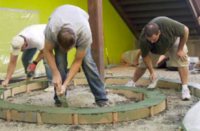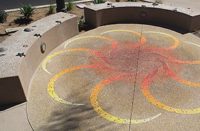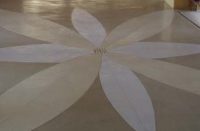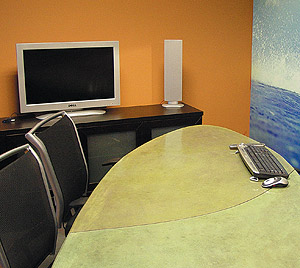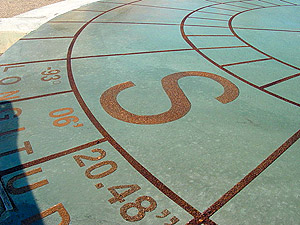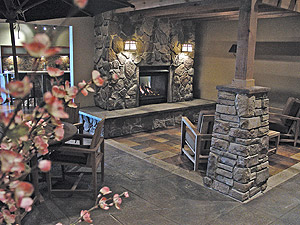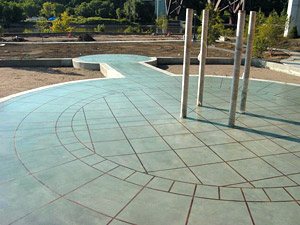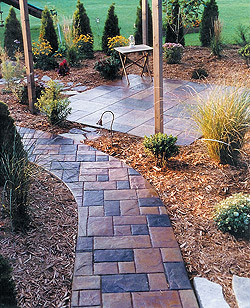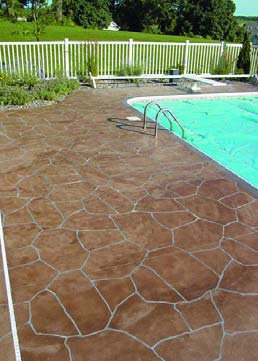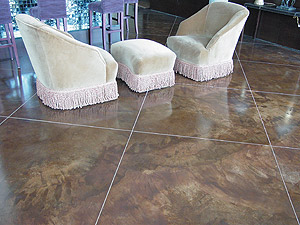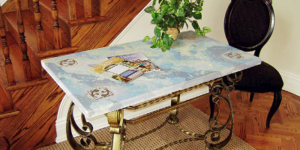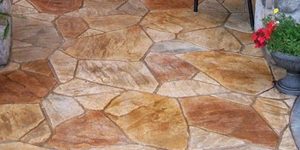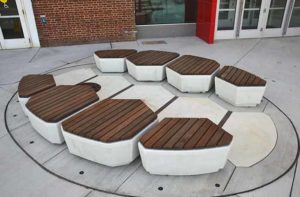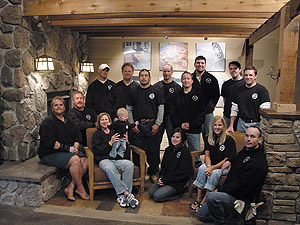
One question Chris Becker often hears is, “Why does your work look so different from everyone else’s?”
Becker, founder and president of Becker Architectural Concrete Inc., in St. Paul, Minn., believes the answer lies in his commitment to bringing a high-quality, professional approach to the installation, design and marketing of architectural concrete.
The creativity and innovation of Becker Architectural Concrete is evident in homes, buildings and parks all around St. Paul, but it’s not limited to concrete. Chris Becker’s creative abilities also shine through in the way he manages and markets his business.
Becker came to architectural concrete in a roundabout way. Studying journalism at the University of Minnesota, he worked summers in concrete restoration. A slow job market when he graduated in 1989 led him to take a sales job with a ready-mix business, and he soon became director of marketing for the $100 million company. This put him in the right place at the right time to spot the opportunities in architectural concrete as it began to take off in the early 1990s. He left the corporate world to work with an experienced contractor, learning hands-on how to install decorative concrete, how to run jobs in the field and how to manage a business.
Finally, in 2002 he was ready to go on his own. “So many people in architectural concrete come from a traditional concrete business. I came from a background in innovation and marketing. My goal from the beginning was to bring a more polished, educated and classy point of view to the industry,” Becker explains. He brings that point of view to three areas that are key to his business: installation, design and marketing.
Technique you don’t see
The first element that sets Becker Architectural Concrete apart is nearobsessive attention to detail. “A lot of it is having your own name on the company,” Becker explains. “You have a distinctive energy to make sure every job turns out fantastic. We set the bar higher than most customers themselves would because this is still a new, very subjective industry.”
Becker insists that his crews “leave no trace” — no hint of how the natural CIRCLE #33 ON READER SERVICE CARD look of a project was achieved. In other words, there should be no error to give a clue of how a color hardener was thrown or how a stamp was placed. A successful project by this definition depends on both skill and artistry.
This philosophy drove Becker to put together a team — 11 field technicians, an interior design intern, three administrative specialists and a sales professional — that shares his vision. Diverse skills are brought together to work on a single goal.
“There is a neat crossover of skills learned in a short time,” Becker says. “We need both disciplines — technical expertise and artistic creativity — in one team.” Potential employees must not only have excellent technical capabilities, but also share Becker’s passion for detail and creative expression.
Beauty you can see
This passion is evident in the second element that sets Becker apart: his approach to design, particularly color. One of his most unusual projects was a monumental navigational compass for the playground at St. Paul’s Riverfront Park. This playground was intended to capture the spirit of the riverfront, but its creators had no idea how to build the compass. Becker Architectural Concrete came up with the solution. They scanned blueprints to create laser-cut templates big enough to cover 1,800 square feet. They colored the fresh concrete with a green color hardener and used the template to sandblast latitude and longitude lines and letters. These etched lines were then colored by hand. This project won first place for innovation from the Aggregate Ready- Mix Association of Minnesota, one of four such awards Becker has earned in less than three years.
It doesn’t require a large-scale landscape project to showcase Becker’s innovation. He has developed a way of integrally coloring concrete for countertops that allows him to match paint chips so homeowners and interior designers can have any color they want. All he needs is the name and number of the paint color. In one unusual case, he colored counters for a cabinet maker in steel gray and electric lime. At a recent home show, he displayed copper/green concrete counters next to the matching paint sample. “This kind of demonstration gets people really excited about the ability to customize,” Becker says.
A place to see it all
Becker’s penchant for innovation extends to the way he markets his business, the third element that sets him apart. He is one of a growing number of contractors who use a showroom to spotlight the range of possibilities of architectural concrete.
Rather than chase around giving onsite estimates, he invites prospects to bring a sketch of their project to the company’s showroom for their first meeting. There, instead of walking into a room full of samples, they walk into a kitchen. The kitchen floor is designed with a stamped polymer overlay colored with a chemical stain. (Becker favors stains or integral color for the cementitious microtoppings and stampable overlays he uses for interiors.) The kitchen’s integrally colored countertops coordinate with IKEA cabinets installed to show budgetminded homeowners they can still decorate with flair. Walking through the kitchen, visitors step “outside” — where they see the façade of a house, complete with porch, courtyard and overhead arbor, all in concrete.
A tour of the showroom often finishes in the “board room,” so named for its 12-foot table in the shape of a surfboard. This table is a sample of reverse-cast technique, where a form is built and the concrete poured in the shop under controlled conditions. The finished piece is installed with the smooth surface created by the bottom of the form facing up, allowing for a much more refined and polished finished surface. Reverse casting in the shop is more efficient and less complicated than casting in place in a client’s home.
The showroom approach reduces the time Becker spends following unproductive leads, but more importantly, gets customers enthused about their own creative vision.
This same approach paid off for Becker at a recent home show with the theme “Weekend in the Wine Country.” His display, set behind a “storefront” modeled after a California street, featured kitchen counters in rich grays, terra cotta and aqua, colored to match the Benjamin Moore Paints spring color palette. The counters were imprinted with an Ashlar slate pattern and then individual stones were handcolored for a natural look. Stepping past the kitchen, visitors to the booth stepped into an outdoor room displaying all the techniques — integral color, chemical staining, shake-on hardeners, imprinting and stenciling — that Becker uses on exterior projects.
Besides marketing to homeowners and builders, Becker spends considerable resources educating designers and landscape architects. After starting with box lunch programs at their offices, Becker has progressed to sponsoring “field trips” to his showroom. These often result in a client visit within a month or two. He also offers training in advanced techniques to contractors from other markets.
So where does the company go from here? Becker sees great things in the future for architectural concrete. “Applications are unfolding on themselves as people find uses for a material that has proved itself for a long time,” he says. “Young designers have studied concrete more and embrace it as a versatile, sustainable, environmentally correct product to use. And so they are willing to take risks and look at different things, like furniture and wallcoverings.” And wherever architectural concrete goes, you can bet Chris Becker will be there, one step ahead.
